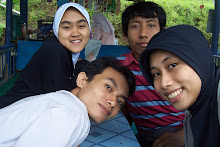The 9 o'clock sun on May 3 began to burn down on those assembled at Angke-Kapuk Nature Recreation Park (TWA Angke-Kapuk) in North Jakarta. The air was becoming hotter and hotter, but this did not wilt the high spirits of the hundreds who had come from the Regina Caely Church Community in Pantai Indah Kapuk and from the Telkom Vocational Senior High School) in Daan Mogot, West Jakarta, to listen to Murni's briefing on mangrove-planting techniques.
"Thank you for coming to plant mangroves to commemorate Earth Day of April 22. The mangroves we plant here are very important and beneficial for the city's health and well-being," said Murni at the end of the briefing.
"Thank you to the students from Telkom vocational school. They have just finished their national exams, and are celebrating it by planting mangroves," she added.
Sri Lela Murniwati, 64, who is known simply as Ibu Murni, has been working at the TWA Angke-Kapuk since 1998, when she received a decree by then forestry minister Djamaluddin Suryohadikusumo appointing her to manage the 99-hectare coastal park.
Murni's entry to reforestation is unique. One day when she visited Benoa, Bali, she saw the lush vegetation of mangroves growing there, and was inspired her to green an area.
She began looking for a place in Bali that needed reforestation, but encountered several obstacles in the process. She thus switched her sights on the nation's capital and quickly learned of Jakarta's dire need for regreening its mangrove forests. It was the beginning of her commitment to TWA Angke-Kapuk's reforestation.
The preservation of mangroves (Rhizopora mucronata) along Java's coastline is a necessity. A mangrove forest acts as a buffer against coastal abrasion, including withstanding tsunamis. It also absorbs pollutants and increases the ratio of dissolved oxygen in the waters, and so becomes a vital breeding and feeding ground in the marine eco-system.
"When the reforestation succeeds, we will have a green belt of mangroves in Jakarta that stretches from TWA Angke-Kapuk to the Pantai Indah Kapuk coast and all the way to the Muara Angke Wildlife reserve," said Resijati Wasito, an official with the local Natural Resources Conservation Center (BKSDA).
Recent studies indicate that mangrove areas along Jakarta's coasts had dwindled rapidly to 118 hectares today, compared to 1,314 hectares in 1960. The swift and unchecked disappearance of mangrove forests has caused the extinction of several native animal species, among them the mangrove cat (Prionailurus viverinus), the water dog (Lutra perspillata) and the forest duck (Cairina scutulata).
Wuria, one student who participated in the mangrove replanting, said that TWA Angke-Kapuk was a good place to play and introduce nature to children. She noted that the park was still home to monitor lizards (Varanus salvator), minor egrets (Egretta garzetta), pied fantails (Rhipidura javanica) and several other small, wetlands bird species.
The one-day event, which was organised by the park, aimed to begin redressing Jakarta's environmental balance by checking the disappearance of the capital's native mangrove forests. The hundreds of volunteers who assembled to do their part for everyone's environment - and planet - planted a total of 1,000 saplings that day.
"It's nice to do something good for nature," shop owner Eng Ben commented at the end of a hot day spent splashing around in chest-high waters
http://www.thejakartapost.com/news
Saturday, May 24, 2008
Subscribe to:
Comments (Atom)

